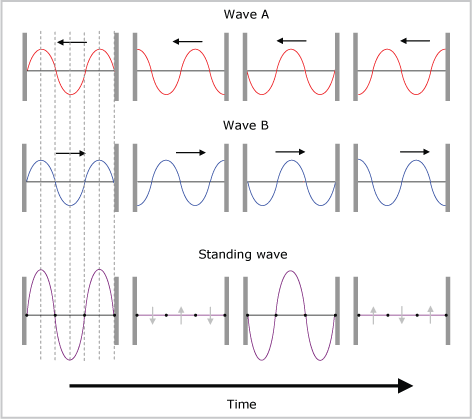Standing waves
A standing wave is a type of interference phenomenon caused by reflected travelling waves. The name is derived from the fact that the wave oscillates and appears to be standing, not travelling.
Standing waves will occur if interfering travelling waves have the same:
- frequency
- speed
- amplitude and are travelling in opposite directions.
Mechanical and non-mechanical waves can create standing waves.
Examine a transverse mechanical standing wave.

Explanation of standing waves
It is convenient to explain standing waves using transverse waves, however, the explanation is also valid for longitudinal waves.
The diagrams below show how two travelling transverse waves (A and B) can create a standing wave between two parallel, rigid walls.

The bottom set of diagrams show how the standing wave varies in displacement with time based on the principle of superposition. Nodes are always formed at either end (wall surface) and often in between (two nodes shown in the diagrams).
If there are no damping forces such as friction, the energy within the standing wave is trapped between the nodes causing the medium to oscillate forever; transforming kinetic energy into potential energy and vice versa.
The diagrams can be interpreted as a longitudinal standing wave if you think of the curves as representing the horizontal displacement of particles from their mean positions but rotated 90°.

1 |
What frequency must a travelling wave have in relation to another travelling wave to create a standing wave? |
2 |
What is the minimum number of antinodes for a standing wave? |
3 |
A travelling sound wave with an amplitude of 5.0 cm is reflected off a large, smooth wall, opposite to its initial direction. What is the amplitude of the standing wave formed from the interference of the two waves? |





